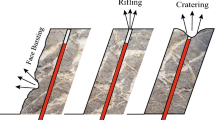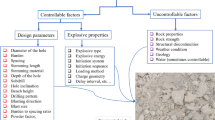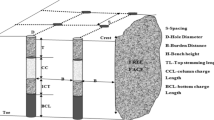Abstract
Mean fragment size is an important index in mine blasting since it significantly influences downstream work efficiency. Therefore, it is necessary to carry out the characteristic particle size prediction of rock fragments. Aiming at this topic, this study presents convolutional neural network (CNN), multilayer perceptron (MLP) and grey wolf optimization (GWO) algorithm, for predicting mean fragment size. The blasting data from multiple open pit mines is collected and augmented, and a large-scale database is established to conduct various parametric studies for both CNN and MLP models to obtain the best one. Then, the GWO algorithm is used to optimize the training process of the above model with the best training and validation performance to further improve the model performance. The results show that the best CNN model has a higher capacity in predicting mean fragment size than the MLP model and the GWO optimization algorithm can further improve the model performance. The model performance can be evaluated by four statistical indices, including mean square error (MSE), root mean square error (RMSE), prediction accuracy and coefficient of determination (R2). The GWO-CNN model and data augmentation method proposed in this study can be introduced as an applicable method for estimating the mean fragment size in mine blasting.













Similar content being viewed by others
Data availability
No datasets were generated or analysed during the current study.
References
Amoako R, Jha A, Zhong S (2022) Rock fragmentation prediction using an artificial neural network and support vector regression hybrid approach. Mining 2:233–247. https://doi.org/10.3390/mining2020013
Badroddin M, Bakhtavar E, Khoshrou H, Rezaei B (2013) Efficiency of standardized image processing in the fragmentation prediction in the case of Sungun open-pit mine. Arab J Geosci 6:3319–3329. https://doi.org/10.1007/s12517-012-0552-3
Bahrami A, Monjezi M, Goshtasbi K, Ghazvinian A (2011) Prediction of rock fragmentation due to blasting using artificial neural network. Eng Comput 27:177–181. https://doi.org/10.1007/s00366-010-0187-5
Bamford T, Esmaeili K, Schoellig AP (2021) A deep learning approach for rock fragmentation analysis. Int J Rock Mech Min Sci 145:104839. https://doi.org/10.1016/j.ijrmms.2021.104839
Bhagade NV, Murthy VMSR, Ali MS (2021) Enhancing rock fragmentation in dragline bench blasts using near-field ground vibration dynamics and advanced blast design. Powder Technol 381:421–439. https://doi.org/10.1016/j.powtec.2020.12.046
Brady BHG, Brown ET (2006) Rock mechanics: for underground mining. Springer Science and Business, Dordrecht
Chen H, ** Y, Li G, Chu B (2018) Automated cement fragment image segmentation and distribution estimation via a holistically-nested convolutional network and morphological analysis. Powder Technol 339:306–313. https://doi.org/10.1016/j.powtec.2018.08.015
Cho J, Lee K, Shin E, Choy G, Do S (2015) How much data is needed to train a medical image deep learning system to achieve necessary high accuracy? ar**v Prepr, ar**v151106348. https://doi.org/10.48550/ar**v.1511.06348
Cunningham CVB (1983) The Kuz-Ram model for prediction of fragmentation from blasting. In: Proceedings of First International Symposium on Rock Fragmentation by Blasting, pp 439–453
Cunningham CVB (2005) The Kuz-Ram fragmentation model--20 years on. In: Brighton conference proceedings, pp 201–210
Dimitraki L, Christaras B, Marinos V, Vlahavas I, Arampelos N (2019) Predicting the average size of blasted rocks in aggregate quarries using artificial neural networks. Bull Eng Geol Env 78:2717–2729. https://doi.org/10.1007/s10064-018-1270-1
Ding Z, Nguyen H, Bui X, Zhou J, Moayedi H (2020) Computational intelligence model for estimating intensity of blast-induced ground vibration in a mine based on imperialist competitive and extreme gradient boosting algorithms. Nat Resour Res 29(2):751–769. https://doi.org/10.1007/s11053-019-09548-8
Djordjevic N (1999) A two-component model of blast fragmentation. In: AusIMM Proceedings, pp 9–13
Enayatollahi I, Aghajani BA, Asadi A (2014) Comparison between neural networks and multiple regression analysis to predict rock fragmentation in open-pit mines. Rock Mech Rock Eng 47:799–807. https://doi.org/10.1007/s00603-013-0415-6
Gao W, Karbasi M, Hasanipanah M, Zhang X (2018) Develo** GPR model for forecasting the rock fragmentation in surface mines. Eng Comput 34:339–345. https://doi.org/10.1007/s00366-017-0544-8
Ghasemi E, Amini H, Ataei M, Khalokakaei R (2014) Application of artificial intelligence techniques for predicting the flyrock distance caused by blasting operation. Arab J Geosci 7:193–202. https://doi.org/10.1007/s12517-012-0703-6
Guo H, Zhou J, Koopialipoor M, Armaghani DJ, Tahir MM (2021) Multilayer perceptron and whale optimization algorithm to assess flyrock induced by blasting. Eng Comput 37:173–186. https://doi.org/10.1007/s00366-019-00816-y
Hasanipanah M, Monjezi M, Shahnazar A, Armaghani DJ, Farazmand A (2015) Feasibility of indirect determination of blast induced ground vibration based on support vector machine. Measurement 75:289–297. https://doi.org/10.1016/j.measurement.2015.07.019
Hinton GE, Salakhutdinov RR (2006) Reducing the dimensionality of data with neural networks. Science 313:504–507. https://doi.org/10.1126/science.1127647
Howard AG (2013) Some improvements on deep convolutional neural network based image classification. ar**v Prepr ar**v13125402. https://doi.org/10.48550/ar**v.1312.5402
Hudaverdi T, Kulatilake PHSW, Kuzu C (2011) Prediction of blast fragmentation using multivariate analysis procedures. Int J Numer Anal Meth Geomech 35:1318–1333. https://doi.org/10.1002/nag.957
Hudaverdi T, Guclu E, Kuzu C (2009) Application of heavy ANFO explosives in quarries nearby Istanbul. In: Proceedings of Nineth International Symposium on Rock Fragmentation by Blasting, pp 111–116
Iwana BK, Uchida S (2021) An empirical survey of data augmentation for time series classification with neural networks. PLoS ONE 16:e0254841. https://doi.org/10.1371/journal.pone.0254841
Kiranyaz S, Avci O, Abdeljaber O, Ince T, Gabbouj M, Inman D (2021) 1D convolutional neural networks and applications: a survey. Mech Syst Signal Process 151:107398. https://doi.org/10.1016/j.ymssp.2020.107398
Kulatilake PHSW, Qiong W, Hudaverdi T, Kuzu C (2010) Mean particle size prediction in rock blast fragmentation using neural networks. Eng Geol 114:298–311. https://doi.org/10.1016/j.enggeo.2010.05.008
Latham JP, Lu P (1999) Development of an assessment system for the blastability of rock masses. Int J Rock Mech Min Sci 36:41–55. https://doi.org/10.1016/S0148-9062(98)00175-2
LeCun Y, Bengio Y, Hinton G (2015) Deep learning. Nature 521:436–444. https://doi.org/10.1038/nature14539
Lecun Y, Bottou L, Bengio Y, Haffner P (1998) Gradient-based learning applied to document recognition. In: Proceedings of the IEEE 86:2278–2324. https://doi.org/10.1109/5.726791
Li E, Yang F, Ren M, Zhang X, Zhou J, Khandelwal M (2021) Prediction of blasting mean fragment size using support vector regression combined with five optimization algorithms. J Rock Mech Geotech Eng 13:1380–1397. https://doi.org/10.1016/j.jrmge.2021.07.013
Liu JC, Zhang Z (2020) A machine learning approach to predict explosive spalling of heated concrete. Arch Civ Mech Eng 20:134. https://doi.org/10.1007/s43452-020-00135-w
Luo C, Li X, Wang L, He J, Li D, Zhou J (2018) How does the data set affect CNN-based image classification performance? In: 2018 5th International Conference on Systems and Informatics (ICSAI), pp 361–366. https://doi.org/10.1109/ICSAI.2018.8599448
Mikołajczyk A, Grochowski M (2018) Data augmentation for improving deep learning in image classification problem. In: 2018 International Interdisciplinary PhD Workshop (IIPhDW), pp 117–122. https://doi.org/10.1109/IIPHDW.2018.8388338
Mojtahedi SFF, Ebtehaj I, Hasanipanah M, Bonakdari H, Amnieh HB (2019) Proposing a novel hybrid intelligent model for the simulation of particle size distribution resulting from blasting. Eng Comput 35:47–56. https://doi.org/10.1007/s00366-018-0582-x
Monjezi M, Rezaei M, Varjani AY (2009) Prediction of rock fragmentation due to blasting in Gol-E-Gohar iron mine using fuzzy logic. Int J Rock Mech Min Sci 46:1273–1280. https://doi.org/10.1016/j.ijrmms.2009.05.005
Ouchterlony F, Niklasson B, Abrahamsson S (1990) Fragmentation monitoring of production blasts at MRICA. In: Proceedings of Third International Symposium on Rock Fragmentation by Blasting, pp 283–289
Ouchterlony F, Sanchidrián JA (2019) A review of development of better prediction equations for blast fragmentation. J Rock Mech Geotech Eng 11:1094–1109. https://doi.org/10.1016/j.jrmge.2019.03.001
Rad HN, Bakhshayeshi I, Jusoh WAW, Tahir MM, Foong LK (2020) Prediction of flyrock in mine blasting: a new computational intelligence approach. Nat Resour Res 29(2):609–623. https://doi.org/10.1007/s11053-019-09464-x
Sachpazis CI (1990) Correlating Schmidt hardness with compressive strength and Young’s modulus of carbonate rocks. Bull Eng Geol Env 42:75–83
Salakhutdinov R, Tenenbaum JB, Torralba A (2013) Learning with hierarchical-deep models. IEEE Trans Pattern Anal Mach Intell 35:1958–1971. https://doi.org/10.1109/TPAMI.2012.269
Shad HIA, Sereshki F, Ataei M, Karamoozian M (2018) Investigation of the rock blast fragmentation based on the specific explosive energy and in-situ block size. Int J Min Geo Eng 52:1–6. https://doi.org/10.22059/ijmge.2018.65613
Sharma SK, Rai P (2017) Establishment of blasting design parameters influencing mean fragment size using state-of-art statistical tools and techniques. Measurement 96:34–51. https://doi.org/10.1016/j.measurement.2016.10.047
Shi X, Zhou J, Wu B, Huang D, Wei W (2012) Support vector machines approach to mean particle size of rock fragmentation due to bench blasting prediction. Trans Nonferrous Metals Soc China 22:432–441. https://doi.org/10.1016/S1003-6326(11)61195-3
Staggs MS (1990) Influence of shot design parameters on fragmentation. In: Proceedings of Third International Symposium on Rock Fragmentation by Blasting, pp 311–317
Vu T, Bao T, Hoang QV, Drebenstetd C, Hoa PV, Thang HH (2021) Measuring blast fragmentation at Nui Phao open-pit mine, Vietnam using the Mask R-CNN deep learning model. Min Technol 130:232–243. https://doi.org/10.1080/25726668.2021.1944458
**e C, Nguyen H, Bui XN, Choi Y, Zhou J, Trang TN (2021) Predicting rock size distribution in mine blasting using various novel soft computing models based on meta-heuristics and machine learning algorithms. Geosci Front 12:101108. https://doi.org/10.1016/j.gsf.2020.11.005
Yaghoobi H, Mansouri H, Farsangi MAE, Nezamabadi-Pour H (2019) Determining the fragmented rock size distribution using textural feature extraction of images. Powder Technol 342:630–641. https://doi.org/10.1016/j.powtec.2018.10.006
Yang Z, He B, Liu Y, Wang D, Zhu G (2021) Classification of rock fragments produced by tunnel boring machine using convolutional neural networks. Autom Constr 125:103612. https://doi.org/10.1016/j.autcon.2021.103612
Yu Z, Shi X, Zhou J, Chen X, Miao X, Teng B, Ipangelwa T (2020) Prediction of blast-induced rock movement during bench blasting: use of gray wolf optimizer and support vector regression. Nat Resour Res 29(2):843–865. https://doi.org/10.1007/s11053-019-09593-3
Zhang ZX (2016) Rock fracture and blasting: theory and applications. Butterworth-Heinemann
Zhang X, Nguyen H, Bui X, Le HA (2020a) Evaluating and predicting the stability of roadways in tunnelling and underground space using artificial neural network-based particle swarm optimization. Tunn Undergr Space Technol 103:103517. https://doi.org/10.1016/j.tust.2020.103517
Zhang Z, Hou D, Guo Z, He Z, Zhang Q (2020b) Experimental study of surface constraint effect on rock fragmentation by blasting. Int J Rock Mech Min Sci 128:104278. https://doi.org/10.1016/j.ijrmms.2020.104278
Zhang X, Li Z, Shi Y, Wu C, Li J (2022) Fragility analysis for performance-based blast design of FRP-strengthened RC columns using artificial neural network. J Build Eng 52:104364. https://doi.org/10.1016/j.jobe.2022.104364
Zhou X, Armaghani DJ, Ye J, Khari M, Motahari MR (2021) Hybridization of parametric and non-parametric techniques to predict air over-pressure induced by quarry blasting. Nat Resour Res 30(1):209–224. https://doi.org/10.1007/s11053-020-09714-3
Zhu PG (2019) Study on blasting fragmentation prediction of rock-fill dam based on random forest regression algorithm. Tian** University
Funding
This work was funded by the Youth Foundation of State Key Laboratory of Explosion Science and Technology (grant number QNKT23-09).
Author information
Authors and Affiliations
Contributions
Kai Rong and Xuan Xu wrote the main manuscript and prepared all the figures. Haibo Wang collected the training data. And Jun Yang contributed ideas and supervision to this research. All authors reviewed the manuscript.
Corresponding author
Ethics declarations
Competing interests
The authors declare no competing interests.
Additional information
Communicated by H. Babaie
Publisher's Note
Springer Nature remains neutral with regard to jurisdictional claims in published maps and institutional affiliations.
Rights and permissions
Springer Nature or its licensor (e.g. a society or other partner) holds exclusive rights to this article under a publishing agreement with the author(s) or other rightsholder(s); author self-archiving of the accepted manuscript version of this article is solely governed by the terms of such publishing agreement and applicable law.
About this article
Cite this article
Rong, K., Xu, X., Wang, H. et al. Prediction of the mean fragment size in mine blasting operations by deep learning and grey wolf optimization algorithm. Earth Sci Inform (2024). https://doi.org/10.1007/s12145-024-01313-7
Received:
Accepted:
Published:
DOI: https://doi.org/10.1007/s12145-024-01313-7




